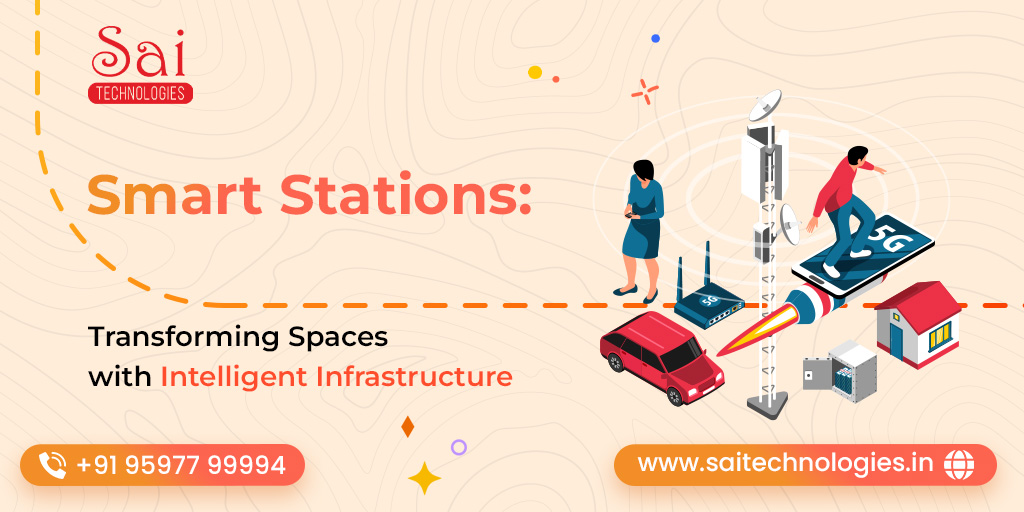Smart Stations
Transforming Spaces with Intelligent Infrastructure

Introduction:
In today's urbanization, transportation infrastructure is important. Smart stations represent a revolutionary approach to urban transportation that combines advanced technology with smart infrastructure to create fast and sustainable transportation hubs. From optimizing passenger flow to improving safety and environmental sustainability, these innovative stations are changing the way people move around the city. In this blog, we will take a closer look at the main features and benefits of smart stations and explore how smart stations can change urban transportation.
Learn smart stations:
Smart stations are more than just transportation hubs; an interconnected ecosystem designed to enhance the travel experience while addressing urban transportation challenges. At the heart of smart stations are advanced technologies such as Internet of Things (IoT) sensors, data analysis and artificial intelligence (AI) that enable rapid monitoring, analysis and decision-making.
Advanced technology integration:
Smart stations use IoT sensors placed throughout the structure to collect data on passenger flow, air quality, energy use, and more. These sensors provide valuable insights that allow public transport authorities to optimize operations, increase efficiency and improve the passenger experience. For example, real-time data on crowd size can help station managers adjust staffing levels and better allocate resources, thereby reducing polling and waiting times. .
Improve the passenger experience:
One of the main goals of smart stations is to improve the passenger experience by providing connectivity and access to information. Digital displays, interactive kiosks and mobile apps provide instant updates on schedules, routes and transport options, allowing travelers to plan their journeys. In addition, facilities such as Wi-Fi connectivity, charging stations and comfortable lounges meet the needs of modern passengers, making their travel experience even more enjoyable.
Improve security:
Safety and security are important to any transportation facility, and smart stations are equipped with advanced systems to address these concerns. Video surveillance, facial recognition technology and threat detection algorithms help identify potential security threats, so law enforcement agencies can respond quickly. Additionally, improved lighting, emergency call boxes and clear signage will help create a safer environment for passengers and crew.
Life and environmental impact:
These smart stations are designed with sustainability in mind, and combine energy saving and renewable energy technologies to reduce environmental impact. Lighting, smart heating and cooling systems and solar panels reduce energy consumption and carbon emissions, and waste management systems encourage recycling and waste reduction. By adopting environmentally friendly methods, smart stations contribute to the overall goal of creating greener and more sustainable cities.
Study example:
To illustrate the impact of smart stations, let's look at two real-world examples:
Toronto Union Station:
Union Station in Toronto, Canada has undergone extensive renovations and has been transformed into a smart station. The project involves the integration of IoT sensors, digital displays and mobile applications to enhance the passenger experience and increase operational efficiency. Passengers can now get data on train schedules, platform availability and transport options, thereby reducing waiting times and congestion. In addition, the lighting and cooling systems and waste management measures reduce the station's environmental impact.
London King's Cross Station:
King's Cross Station in London implements the smart station concept with its innovative use of technology and sustainable development aspects. The station's infrastructure includes the installation of IoT sensors to monitor passenger flow, optimize traffic management and improve accessibility. Digital displays and mobile apps provide up-to-date train travel information on train schedules, platform changes and nearby locations. In addition, energy-efficient lighting, green spaces and rainwater harvesting systems demonstrate a commitment to environmental sustainability.
Union Station in Toronto, Canada is a prime example of how smart stations are transforming urban transportation. Union Station's transformation includes a complete overhaul of its infrastructure and services, and the introduction of advanced technology to increase efficiency and enhance the passenger experience. Due to its central location and status as a major transportation hub, Union Station is a major transit point for passengers in and out of the Toronto Region.
One of the key features of the updated Union Station is the integration of IoT sensors throughout the building. These sensors collect real-time data on passenger flows, train schedules, platform availability and environmental conditions, so station managers can make decisions to optimize operations. For example, crowd density data can help staff allocate resources more efficiently, regulate customer flow, and reduce congestion during peak hours. In addition, IoT servers enable predictive maintenance, so maintenance personnel can resolve potential problems before they escalate, thereby reducing service disruptions and increasing reliability.
In addition to IoT sensors, Union Station has digital displays and mobile apps to provide passengers with up-to-date information on train schedules, platform changes and nearby equipment. These digital tools allow travelers to plan their trips and make informed decisions about their transportation options. For example, passengers can use mobile apps to check arrival times, track delays, and receive alerts about service problems, so they can adjust their plans trip.
In addition, Union Station has implemented various sustainability initiatives to reduce its environmental impact. Lighting and heating systems have been installed throughout the building, reducing energy consumption and lowering operating costs. In addition, waste management programs such as recycling programs and compost bins help reduce the amount of waste generated at the station. In addition, Union Station is also using green building techniques, incorporating features such as green roofs and rainwater harvesting systems to promote environmental sustainability. Another example of a smart station is King's Cross Station in London, England.
To conclude:
Smart stations represent a paradigm shift in urban transportation, harnessing the power of technology to create more efficient, sustainable, and passenger-friendly transportation. By incorporating advanced technology, enhancing the passenger experience and ensuring safety and sustainability, these innovative stations are reshaping the future of urban transport. As cities continue to grow and expand, smart stations will play an important role in shaping the way people move within and between cities, ultimately helping to create smart city, good life for everyone.

